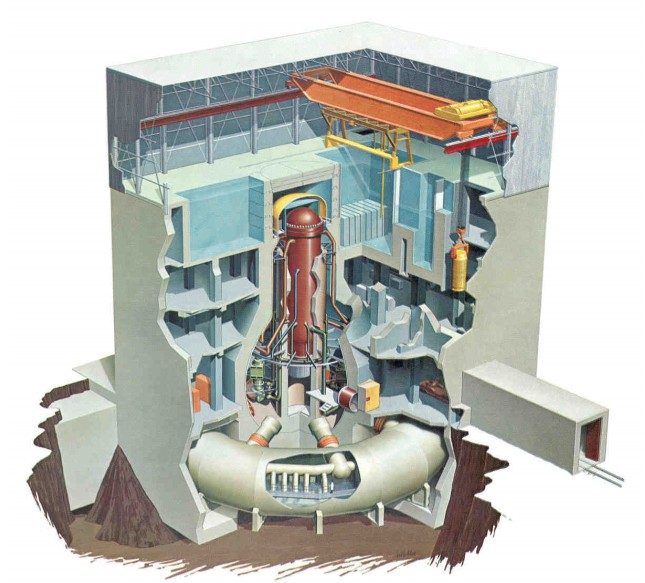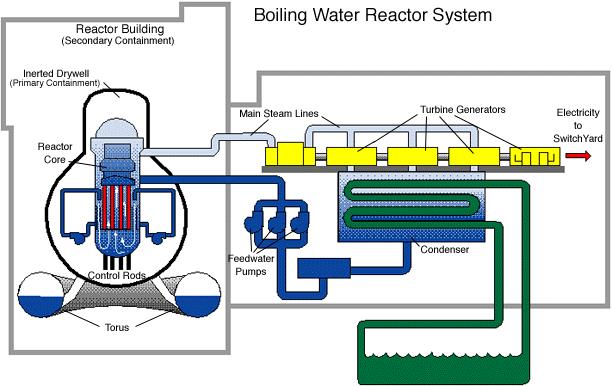UPDATE 14: 23.44 pm GMT
Attention remains focused on the Fukushima Daiichi and Daini nuclear power plants as Japan struggles to cope in the aftermath of its worst earthquake in recorded history. A dramatic explosion did not damage containment and sea water injection continues through the night.
Three of Fukushima Daiichi's six reactors were in operation when yesterday's quake hit, at which point they shut down automatically and commenced removal of residual heat with the help of emergency diesel generators. These suddenly stopped about an hour later, and this has been put down to tsunami flooding by the International Atomic Energy Agency (IAEA).
The loss of the diesels led the plant owners Tokyo Electric Power Company (Tepco) to immediately notify the government of a technical emergency situation, which allows officials to take additional precautionary measures.
For many hours the primary focus of work at the site was to connect enough portable power modules to fully replace the diesels and enable the full operation of cooling systems.
Pressure and releases
Without enough power for cooling systems, decay heat from the reactor cores of units 1, 2 and 3 has gradually reduced coolant water levels through evaporation. The consequent increase in pressure in the coolant circuit can be managed via pressure release valves. However, this leads to an increase in pressure within the reactor building containment. Tepco has said that the pressure within the containment of Fukushima Daiichi 1 reached levels of around 840 kPa, compared to reference levels of 400 kPa.
The company decided to manage this "for those units that cannot confirm certain levels of water injection" by means of a controlled release of air and water vapour to the atmosphere. Because this water has been through the reactor core, this would inevitably mean a certain release of radiation. The IAEA said this would be filtered to retain radiation within the containment. Tepco has confirmed it was in the process of relieving pressure at unit 1 while preparing to do the same for units 2 and 3.
Explosion
Television cameras trained on the plant captured a dramatic explosion surrounding Fukushima Daiichi 1 at around 6pm. Amid a visible pressure release and a cloud of dust it was not possible to immediately know the extent of any damage. Later television shots showed a naked steel frame remaining at the top of the reactor building. The external building structure does not act as the containment, which is an airtight engineered boundary within.
| This cutaway diagram shows the central reactor vessel and thick concrete containment in a typical boiling water reactor of the same era as Fukushima Daiichi 1 |
Chief cabinet secretary Yukio Edano appeared on television to clarify that the explosion had damaged the walls and roof of the reactor building but had not compromised the containment.
Monitoring of Fukushima Daiichi 1 had previously shown an increase in radiation levels detected near to the unit emerging via routes such as the exhaust stack and the discharge canal. These included caesium-137 and iodine-131, Nisa said, noting that levels began to decrease after some time.
Nevertheless the amount of radiation detected at the site boundary reached 500 microSieverts per hour - exceeding a regulatory limit and triggering another set of emergency precautions. It also meant the incident has been rated at Level 4 on the International Nuclear Event Scale (INES) - an 'accident with local consequences'.
To protect the public from potential health effects of radioactive isotopes of iodine that could potentially be released, authorities have made preparations to distribute tablets of non-radioactive potassium-iodide. This is quickly taken up by the body and its presence prevents the take-up of iodine-131 should people be exposed to it.
Over the last several hours evacuation orders for local residents have been incrementally increased and now cover people living within 20 kilometres of the power plant.
Seawater injection
The injection of seawater into parts of the building near the reactor started at 8.20pm and this is planned to be followed by addition of boric acid, which is used to inhibit nuclear reactions. Tepco had to put the operation on hold for a time when another tsunami was predicted, but work recommenced after the all-clear.
Raised temperatures
Meanwhile at adjacent Fukushima Daini, where four reactors have been shut down safely since the earthquake hit, Tepco has notified government of another emergency status.
Unit 1's reactor core isolation cooling system had been operating normally, and this was later supplemented by a separate make-up water condensate system. However, the latter was lost at 5.32am local time when its suppression chamber reached 100ºC. This led Tepco to notify government of another technical emergency situation.
Tepco has announced it has decided to prepare for controlled releases to ease pressure in the containments of all four units at Fukushima Daini.
A ten kilometre evacuation is in progress and across both sites, some 200,000 people have been moved from the homes so far.
Workers
A seriously injured worker was trapped within Fukushima Daiichi unit 1 in the crane operating console of the exhaust stack and is now confirmed to have died. Four workers were injured by the explosion at the same reactor and have been taken to hospital. A contractor was found unconscious and taken to hospital.
Two workers of a 'cooperative firm' were injured, said Tepco; one with a broken bone. A Tepco employee who was unable to stand and grasping his left chest was taken to hospital.
At Fukushima Daiini unit 3 one worker received a radiation dose of 106 mSv. This is a notable dose, but comparable to levels deemed acceptable in emergency situations by some national nuclear safety regulators.
The whereabout of two Tepco workers remains unknown.
Researched and written
by World Nuclear News






_91467.jpg)
_47120.jpg)
_16439.jpg)






